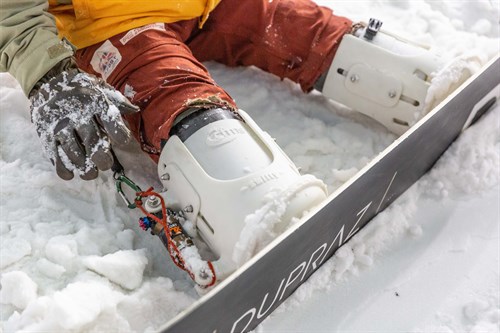4th September. Bristol – A former British Army soldier, who lost both his legs above the knee in a bomb explosion in Northern Ireland, has successfully tested the world’s first 3D-printed snowboard bindings – which he hopes will help him qualify for the 2022 Winter Paralympic Games in China.
Darren Swift (Swifty), in partnership with CFMS, is aiming to revolutionise para-snowboarding by enabling other double above the knee (DAK) amputees to compete against each other, rather than more able-bodied para-athletes.
The new bindings, which have been designed by independent, not-for-profit digital engineering specialists from CFMS, are the first to be able to absorb shock and adjust to different user’s positions. It is hoped that the new bindings will encourage the International Paralympic Committee (IPC) to create a new category for DAKs competitors.
Swifty said: “For 5 years I’ve been competing on heavy bindings put together in a friend’s kitchen. They gave me permanent back pain and meant I was too slow to qualify for the 2018 Winter Paralympic Games. I wanted to create something that could open doors for me and other DAKs competitors. With CFMS’s help, we’ve developed something revolutionary and now we’re calling on the IPC to help DAKs compete equally.”
CFMS has developed and tested the bespoke bindings using a series of 3D modelling, additive manufacturing and complex high value design techniques. More than 500 digital engineering hours have been dedicated to the development of the prototype bindings, which have been 3D-printed using glass-reinforced nylon to increase stiffness and performance.
Davide Bianchi, Head of Advanced Simulation at CFMS who led the project, commented: “When Darren first approached us with the idea for the bindings, we jumped at the chance to get involved. As experienced aerospace engineers, we knew we had the skills to design exactly what he needed. We’ve really pushed the limits of engineering to create the world’s first 3D-printed snowboard bindings so we’re really proud to see Darren on the slopes using this revolutionary new technology!”
CFMS has provided support for the project on a pro-bono basis and worked alongside Airbus to 3D-print the bindings.
Swifty successfully tested the bindings for the first time on Tuesday 3 September at The Snow Centre in Hemel Hempstead. He will now begin training for the 2022 Paralympic Games in China.
Swifty’s story
In 1991, Swifty lost both his legs in an IED explosion whilst on his third tour in Belfast. Following his recovery and feeling unbeaten by the accident, Swifty decided to try snowboarding, having never taken part in any winter sports before.

After 10 years of sit-skiing, he discovered snowboarding and became involved with the Armed Forces Para Snowsport Team (AFPST). Swifty entered the Winter Paralympic Games in Korea in 2018, but unfortunately, with no category for DAK amputees within the International Paralympic Association, Swifty’s Banked Slalom race times were not sufficient to be selected for the GB Team.
Partnering with longtime friend, Dale Rennard, Swifty set out to create a pair of bindings that would enable him to snowboard more efficiently. The pair created a set of kitchen-made snowboard bindings, which qualified Swifty to become the only DAK Paralympic competitor in the country.
If you would like to know more about the digital engineering techniques and processes used on the Swifty project, read our full case study.